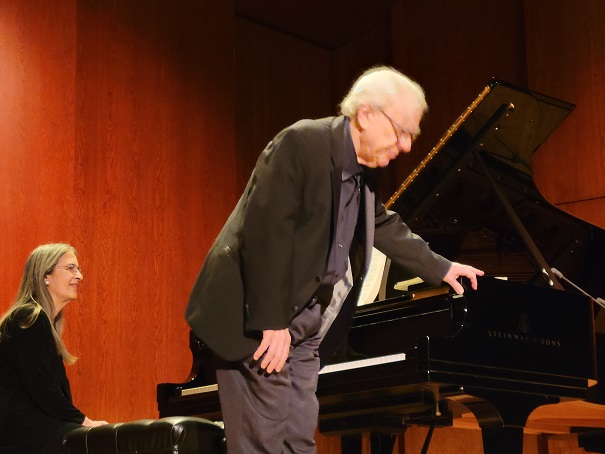Concert Diary: Richard Goode Plays Schubert, Schumann, and Bartok
November 11, 2021
New York, N.Y.
Schubert and Schumann: their names so easy to confuse, their births separated by only 13½ years, but how different is their music and what different personalities that music conveys!
To me, Franz Schubert is shy and reticent but craves intimacy. He takes his time with his music, often content with moderate tempos, confident that the rapport that he’s established with us doesn’t require flash or virtuosity or big climaxes. Schubert doesn’t want to bore us, but we must meet him halfway. We must be patient, savoring every phrase, allowing him to cast his spell.
Last night, New York pianist Richard Goode performed a program at the 92nd Street Y where he became an ideal intermediary between Schubert and ourselves. Sometimes humming along with the music, his wife, violinist Marcia Weinfeld, turning pages for him, Goode began with the first three of Schubert’s Six Moments Musicaux (D. 780), ending with the famous one, and then continued with the Piano Sonata in A Minor (D. 845) with its fascinating second movement theme and variations, a nervous third movement Scherzo, and the allegro Rondo finale.
In contrast, Robert Schumann is a more mysterious figure. Richard Goode performed Schumann’s Papillons (French for “butterflies") of 1831, which is ostensibly a collection of nine waltzes and two polonaises, so we might believe that a waltz is just waltz, and not so different from waltzes that Chopin composed, some before the Schumann work and some after.
Invariably, however, complex stories often hide behind behind Schumann’s piano music, and this is no exception. Papillons was inspired by a masked ball sequence in the novel Flegeljahre by the German author and darling of the Romantic movement, Jean Paul. The title is variously translated as “The Awkward Age” or “Wild Oats,” but its only English translation seems to be one by Eliza Lee in 1846 called Walt and Vult, or The Twins. Here’s a paragraph from that translation in “The Masked-Ball” chapter:
Walt, as he stood thus entranced, intimated that he wished to celebrate and consecrate this sweetest moment of his life, and as Hope passed before them, with the slave of virtue [referring to masks], Wina asked him if he never danced. Immediately they joined the stream of dancers. Although Walt danced as, according to Bottiger, did the Romans, whose mimic dances consisted only of motions of the hands and arms, yet, involved with the flying swarm, he entered into the waltz with that warmth that carried them to the last stage of fatigue. Like a youth who touches for the first time the hand of a great, renowed author, or as gently as with a bufferfly’s wing, or the perfume of the auricula, Walt touched the back of Wina, while he removed himself, as much as the waltz permitted, so as to look into her life-breathing face. (Vol. 2, pg. 288)
How much did this mean to Schumann in the composition of Papillons? Is the mention of “butterfly’s wing” important to the title that Schumann chose? Can there really be 24 mentions of “butterfly” or “butterflies” in the novel?
But why do I even need to consider these extra-musical associations? And what is it about me that compels a reading of a paper in an academic journal entitled "Explicating Jean Paul: Robert Schumann’s Program for Papillons, Op. 2"? The author (Eric Frederick Jensen) establishes that Schumann did indeed correlate the individual pieces of Papillons with passages in Flegeljahre, but much of it was after he had composed the work.
Yet, what this article demonstrated to me most of all is that Schumann’s private inner world will forever be mysterious:
In creating Papillons, Schumann’s intention had been to produce a musical composition with an optional level of perception. The music became intimately associated in his mind with specific scenes from Flegeljahre. Yet no attempt was made to inform the public of the program. Even close friends were only provided with a sketch and an intimation. The title itself was another intimation, intended by Schumann to point the way to Jean Paul in whose works the symbol of the butterfly is so prominent. (pp. 142–3)
At any rate, Richard Goode concluded his recital with a rather incongruous choice: Bartok’s Fifteen Hungarian Peasant Songs, which were not quite as Bartokian as I would have preferred.
After a couple curtain calls, Goode returned to the piano and said “Schubert also wrote Hungarian music.” He then played Schubert’s 1824 piano piece, Hungarian Melody, which might very well have been among the Moments Musicaux, thus coming full circle to conclude the recital.
